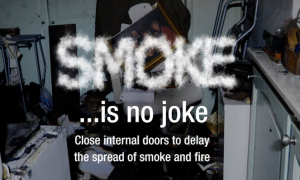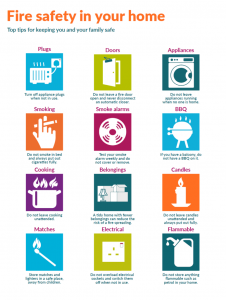The Importance Of A Smoke Alarm!

- You’re around 8 times more likely to die in a fire if you do not have a working smoke alarm in your home.
- Around half of home fires are caused by cooking accidents.
- Two fires a day are started by candles.
- Every six days someone dies from a fire caused by a cigarette.
- About three fires a day are started by heaters.
- Faulty electrics (appliances, wiring and overloaded sockets) cause around 4,000 fires in the home across the country every year.
Protect your home with smoke alarms
The easiest way to protect your home and family from fire is with working smoke alarms.
Get them!
Install them!
Test them!
They could save your life!
Choosing your smoke alarms
- Fit at least one smoke alarm on every level of your home.
- Please be aware that some children may not be woken by smoke alarms.
- Smoke alarms are cheap and easy to install.
- They are available from DIY stores, electrical shops and most high street supermarkets.
- Ten-year sealed battery smoke alarms are the best option. They are slightly more expensive, but you save on the cost of replacing batteries.
- There are a variety of different models to choose from. Your local fire and rescue service will be happy to give you advice on which one is best suited for you.
- Look out for the British Standard Kitemark and Loss Prevention Certification Board (LPCB) symbols, which shows the alarm is approved and safe.
How to make sure your smoke alarms work
- Test your smoke alarms at least monthly, best practice is once a week.
- If any of your smoke alarms have a one-year battery, make sure it is changed every year. Only take the battery out when you need to replace it.
- Never disconnect or take the batteries out of your alarm if it goes off by mistake.
- Standard battery-operated alarms are the cheapest option, but the batteries need to be replaced every year.
- A lot of people forget to test the batteries, so longer life batteries are better.
- Mains-powered alarms are powered by your home power supply and have a back-up battery in case of a power cut. They need to be installed by a qualified electrician and, like battery alarms, they do require testing.
- Testing smoke alarms tests the smoke sensor as well as the power supply and/or battery.
- You can even have linked alarms installed, so that when one alarm detects a fire, they all go off together. This is useful if you live in a large house or over several levels.
- Strobe light and vibrating pad alarms are available for those who are deaf or hard of hearing. Contact the Action on Hearing Loss Information Line on 0808 808 0123 or textphone 0808 808 9000.
Fitting your smoke alarms
- The ideal position is on the ceiling, in the middle of a room, and on the hallway and landing, so you can hear an alarm throughout your home.
- Don’t put alarms in or near kitchens or bathrooms where smoke or steam can set them off by accident.
- If it is difficult for you to fit smoke alarms yourself contact your local fire and rescue service for help. They’ll be happy to install them for you.
Looking after your smoke alarms
- Make testing your smoke alarms part of your regular household routine.
- Test them by pressing the button until the alarm sounds. If it doesn’t sound, you need to replace the battery.
- Vacuum your smoke alarms every six months to remove dust.
- If a smoke alarm starts to beep on a regular basis, you need to replace the battery immediately.
- If it is a ten-year alarm, you will need to replace the whole alarm every ten years.
Taken from : Fire safety in the home (accessible version)








